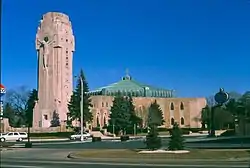National Shrine of the Little Flower Basilica
National Shrine of the Little Flower Basilica Catholic Church is a Catholic church in Royal Oak, Michigan. A designated national shrine, the church building is well-known for its execution in the lavish zig-zag Art Deco style. The structure was completed in two stages between 1931 and 1936. The sanctuary stands at 2100 West Twelve Mile Road at the northeast corner of Woodward Avenue and is a parish of the Archdiocese of Detroit. Construction was funded by the proceeds of the radio ministry of the controversial Father Charles Coughlin who broadcast from the tower during the 1930s.
| National Shrine of the Little Flower Basilica | |
|---|---|
 | |

| |
| Location | Royal Oak, Michigan, US |
| Denomination | Catholic (Latin Rite) |
| Website | www |
| Architecture | |
| Style | Art Deco |
| Years built | 1931–36 |
| Administration | |
| Archdiocese | Archdiocese of Detroit |
History
_-_exterior.jpg.webp)
Named in honor of Saint Thérèse of Lisieux (who was known as "the Little Flower"), the church was first built in 1926 in a largely Protestant area.[1][2] It was founded in 1925, a year before construction started. Within days of the church opening, the Ku Klux Klan burned a cross in front of the church.[3] The original wood structure was destroyed by a fire on March 17, 1936.[4][5] Construction of the new building started in 1931 and ended in 1936. Its completion was spurred by the destruction of the old structure and it employed large amounts of copper and stone to execute the designs of architect Henry J. McGill, of the New York firm of Hamlin and McGill.
Pope Francis designated the Shrine a minor basilica on January 31, 2015.[6][7]
Pastors
- Fr. Charles Coughlin (1925–1966)
- Fr. James L. Hayes (1966–1974)
- Fr. Edward A. Belczak (1975–1980)
- Fr. Edward J. Prus (1975–1987)
- Fr. Edward Haggerty (1987–1990)
- Msgr. John Gordon (1990–1991)
- Msgr. Alexander Joseph Brunett (1991–1994), appointed Bishop of Helena, later Archbishop of Seattle
- Msgr. John Nienstedt (1994–1996)
- Msgr. William Easton (1996–2013)[8]
- Fr. Robert Joseph Fisher (2014–2016)[9]
- Msgr. Robert J. McClory (2016–2020), appointed Bishop of Gary, Indiana
- Fr. Joseph Horn (2020 - Present)
Architecture
_-_Charity_tower_with_Christ's_last_words_from_the_Cross.jpg.webp)
_-_nave%252C_view_from_balcony.jpg.webp)
A dramatic limestone Art Deco tower called the Charity Crucifixion Tower, completed in 1931, features integrated figural sculptures by Rene Paul Chambellan, including a large figure of Christ on the cross, 28 ft (8.5 m) high on the Woodward Avenue façade. The sculpture, using Chambellan's design, was completed by Italian stone carver, Enrico (Harry) Liva, chief carver of the Ingalls Stone Company of Bedford, Indiana.[10][11] It was built as a response to the Ku Klux Klan as a "cross they could not burn".[12] The sides and rear feature windows inside the crucifix which can be lit from within. At the upper corners of the tower are symbols of the Four Evangelists. Carved below the feet of the figure of Christ are the Seven Last Words from the Cross. Just below them is a doorway with "Charity" and "Christ Crucified" carved above it. On the sides of the doorframe are depictions of items associated with the Passion. The doorway leads to a small balcony which can serve as a pulpit. On the front are carved depictions the Archangels Jophiel, Raphael, Michael, Gabriel and Uriel. The pulpit is flanked by depictions of John the Apostle and the Virgin Mary to the left and a Roman Centurion holding a spear and Mary Magdalene on the right.[13] Across the terrace facing the crucifix a depiction of Saint Thérèse of Lisieux is carved into the surrounding wall. This sculpture is also by Chambellan.
Behind the tower are doors leading to a large chapel that connect the tower with the main sanctuary. The altar of the chapel is within the base of the tower. The octagonal nave seats three-thousand on two levels, with the altar in the center. The main building is granite and limestone, with exterior and elaborate interior sculptural work by Corrado Parducci, including a lectern and Stations of the Cross, and hand-painted murals by Beatrice Wilczynski. Set into the exterior walls are stones carved with the names and official flowers of each of the states. The octagon-shaped granite baptismal font was designed by liturgical artists Robert Rambusch and Mario Agustin Locsin y Montenegro.
In 1998, the United States Bishops' Conference declared the site a National Shrine, one of only five in the country according to the church's web site.
References
- Marcus, Sheldon (1973). Father Coughlin: The Tumultuous Life of the Priest of the Little Flower. Little, Brown, and Company. pp. 22–23. ISBN 978-0316545969.
- Tull, Charles J. (1965). Father Coughlin and the New Deal. Syracuse University Press. pp. 2–3. ISBN 978-0815600435.
- Shannon, William V. (1989) [1963]. The American Irish: a political and social portrait. Univ of Massachusetts Press. pp. 298-299. ISBN 978-0-87023-689-1.
Two weeks after the new church was built, the Ku Klux Klan set a cross on fire on the church lawn.
- Hutting, Albert M. (1998) [1936]. Shrine of the Little Flower. Royal Oak: Radio League of the Little Flower. OCLC 32783964.
- "Old Coughlin Church is Destroyed by Fire". The New York Times. Associated Press. March 18, 1936. Retrieved May 6, 2011.
- Hicks, Mark (January 31, 2015). "Pope names Shrine of the Little Flower a basilica". The Detroit News.
- "Pope Francis grants National Shrine of the Little Flower in Royal Oak honorary title of Minor Basilica" (Press release). Archdiocese of Detroit. January 31, 2015. Retrieved 2016-02-09.
- "Pastors and Priests in Service to Shrine Parish". University of Detroit Mercy. Retrieved 31 December 2018.
- "Pope Names New Auxiliary Bishops of Detroit, Michigan, and Orange, California" (Press release). United States Conference of Catholic Bishops. November 23, 2016. Retrieved November 23, 2016.
- "Funeral Set Friday for Harry Liva, One of Stone Belt's Outstanding Carvers." The Bedford Daily-Times Mail Vol. LXIX, No. 231. May 2, 1963.
- Downs, Winfield Scott (1967). Encyclopedia of American Biography: New Series. Volume 36. American Historical Society. p. 314.
- Levin, Doron P. (May 25, 1992). "Royal Oak Journal; Bitter Memories of Anti-Semitism Live On in Michigan Parish". The New York Times. Retrieved May 24, 2011.
- Patterson, Jim; Perrone, Bob (July 2007). "Rene Paul Chambellan - One of Art Deco's Greatest Sculptors". Louisville Art Deco. Retrieved November 19, 2013.
External links
| Wikimedia Commons has media related to National Shrine of the Little Flower. |
